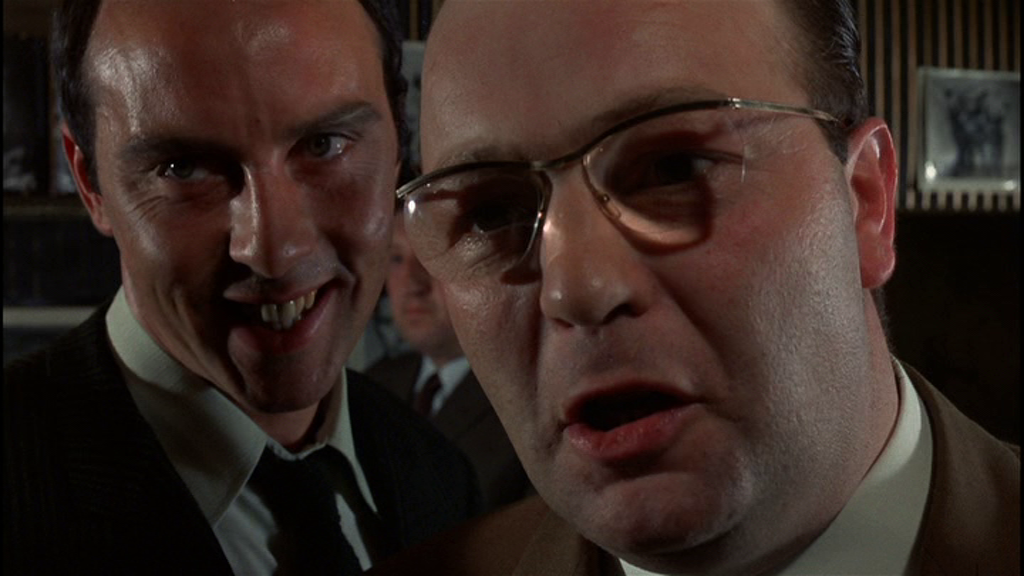
I showed a bit of PERFORMANCE to my students last week as part of a class on filming dialogue — I wanted to show them how interesting and experimental they can get.
The clip got a lot of laughs! The performances do go right to the edge of caricature, but Roeg & Cammell’s framing and cutting are so eccentric that they also invite a knowing response.
The coverage starts off almost conventionally in the establishing shot. There are some freeze-frames, though, accompanying a stills photographer’s flashbulbs — looks like Scorsese picked up on this. Certainly Paul Schrader has cited PERFORMANCE as a particularly good movie to steal from, and a back-to-back viewing with MISHIMA will confirm this.

James Fox’s Chas gets told off by his boss, with accompanying yes-men, while Anthony Valentine, his erstwhile victim, gloats. (Really appreciated Valentine’s work in TO THE DEVIL A DAUGHTER and THE MONSTER CLUB when we podcasted about those).

Once we start seeing closer angles, though, things get weird. There’s an in-your-face quality that’s nightmarish — the lens is wide and the actors are uncomfortably close. It does have an alcoholic quality — that moment when you’ve had a few and you suddenly notice how funny everything looks and feels.
As the scene progresses, the shots and cutting both get more fragmented: Roeg’s framing cuts off parts of faces in a most odd way, reducing characters to mouths or eyes:


When we see Chas, the angles are closer, more centred, lower. The effect is to isolate him from his surroundings. Close-ups and low angles can be used to confer strength, but not here:

Chas breaks into a sweat, and his eyes dart around the room.
Now, Cammell attested that in collaborating with Roeg, he took charge of the actors and Roeg handled the camerawork, and this worked very smoothly. My first geuss about the scene was that maybe the two filmmakers were diverging in their intentions, resulting in the shots feeling really wacky.
But James Fox’s eye movements convince me this is quite false: the crazy angles are actually a subjective rendering of what he’s experiencing, a sort of panic attack, coupled with a dissociation from reality, and a kind of ADHD distracted hyperfocus. Chas is seeing things very clearly, but only in a jumble of bits.


At one point, Cammell and Roeg surprise us by cutting to a b&w photo of a limbo-dancing violinist, then zoom out to catch Anthony Morton in profile. Throughout the scene, Morton freaks us, and Chas, out, but delivering his lines either right down the barrel of the lens, or off into the void.
A similar dissociating effect occurs earlier when everything fades into bluish monochrome and seems to go far away:

Quite scary, in fact. With a change of lens, some experimental colour grading, and rearranging the furniture in the office, the filmmakers have turned the room into one of REPULSION’s distorted nightmare spaces.
That photo on the wall is probably one of the filmmakers’ little connections — tying us to the idea of performance, which is mentioned in the scene (Chas, who “puts the frighteners on flash little twerps,” is a performer whose role is to terrify) — anticipating the musician character we’ll meet later — it also ties up with the photographer and his flashes, and with the b&w subjective imagery from the office scene. The sudden cut to the photo also makes us think a new scene has begun, before the zoom-out reveals that we’re still trapped in this one.
The lesson is, Be bold!
